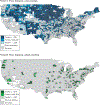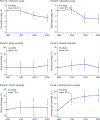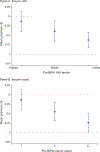Do Larger Health Insurance Subsidies Benefit Patients or Producers? Evidence from Medicare Advantage
- PMID: 30091862
- PMCID: PMC10782851
Do Larger Health Insurance Subsidies Benefit Patients or Producers? Evidence from Medicare Advantage
Abstract
A central question in the debate over privatized Medicare is whether increased government payments to private Medicare Advantage (MA) plans generate lower premiums for consumers or higher profits for producers. Using difference‑in‑differences variation brought about by a sharp legislative change, we find that MA insurers pass through 45 percent of increased payments in lower premiums and an additional 9 percent in more generous benefits. We show that advantageous selection into MA cannot explain this incomplete pass‑through. Instead, our evidence suggests that market power is important, with premium pass‑through rates of 13 percent in the least competitive markets and 74 percent in the most competitive.
Figures










References
-
- Achman Lori, and Gold Marsha. 2002. “Medicare+Choice 1999–2001: An Analysis of Managed Care Plan Withdrawals and Trends in Benefits and Premiums.” New York: Commonwealth Fund.
-
- Agarwal Sumit, Souphala Chomsisengphet, Mahoney Neale, and Stroebel Johannes. 2014. “A Simple Framework for Estimating the Consumer Benefits from Regulating Hidden Fees.” Journal of Legal Studies 43 (S2) : S239–52.
-
- Agarwal Sumit, Chomsisengphet Souphala, Mahoney Neale, and Stroebel Johannes. 2015. “Regulating Consumer Financial Products: Evidence from Credit Cards.” Quarterly Journal of Economics 130 (1): 111–64.
-
- Brown Jason, Duggan Mark, Kuziemko Ilyana, and Woolston William. 2014. “How Does Risk Selection Respond to Risk Adjustment? New Evidence from the Medicare Advantage Program.” American Economic Review 104 (10) : 3335–64. - PubMed
-
- Bulow Jeremy I, and Pfleiderer Paul. 1983. “A Note on the Effect of Cost Changes on Prices.” Journal of Political Economy 91 (1) : 182–85.
MeSH terms
Grants and funding
LinkOut - more resources
Full Text Sources
Other Literature Sources
